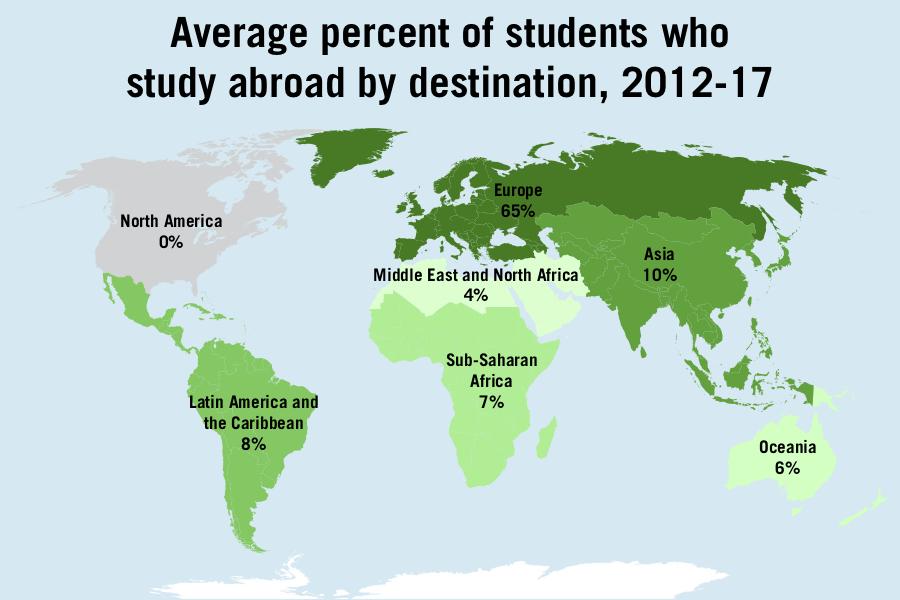Students who study abroad are choosing to travel to Europe at the highest rate in recent history.
About 68 percent of students who study abroad selected countries in Europe as their destination last academic year, up about seven percentage points from the previous year and the highest rate in at least five years. Officials said Europe has always been a top study abroad pick because students feel safer in countries that don’t often make headlines for war or disease, and European countries’ close proximity to one another could offer students more accessible and affordable travel opportunities.
“Students may feel that Europe is ‘familiar’ intellectually/culturally,” Maritheresa Frain, the director of the Office of Study Abroad, said in an email. “Studying abroad for many students is a stretch outside of their comfort zone, so they may be acting conservatively to ensure their successful adaptation to a new culture.”
Next to Europe, Asia was the second-most popular study abroad region, bringing in about 10 percent of students studying abroad. Latin America and the Caribbean came in at No. 3 with roughly 7 percent of students.
Between 55 to 60 percent of students who study abroad nationally have chosen to travel to Europe since 2005, according to data from the annual Open Doors report conducted by the Institute of International Education.
Frain said the high volume of students studying abroad in Europe is “not surprising” because Europe has always been a top study abroad location for GW. Between 2012 and 2017, roughly 60 to 68 percent of study abroad students traveled to the continent annually.
“GW students often learn about programs from other GW students,” Frain said in an email. “When study abroad alums come back and promote their program, they often motivate their fellow students to explore the same destination.”
The University offers 153 study abroad programs in Europe, amounting to more than 50 percent of the University’s total program offerings. GW offers 43 programs in Asia, 33 programs in Latin America and the Caribbean, 18 programs in the Middle East and North Africa, 20 programs in Oceania and 22 programs in Sub-Saharan Africa, she said.
She added that more students may have selected Europe recently because there are “geopolitical challenges” in other locations, like wars in the Middle East and pollution concerns in China. Frain said U.S. news coverage of events like Argentina’s economic crisis or violence in Brazil may lead students to think some countries are too unsafe to visit.
She said Europe may also be the most popular study abroad destination because study abroad “has its roots” in Europe after countries tried to recruit students to take language and culture programs after World War II.
In Europe, the United Kingdom was ranked as the top study abroad destination last academic year, followed by France, Spain and Italy. Outside Europe, China is ranked as the fifth-most popular study abroad site for students, according to institutional data.
Frain said students may choose to study in the United Kingdom because the country houses “excellent universities,” like the universities of Oxford and Cambridge, that are well-known to American students. Because language learning nationally “has been on a downward trend,” she said students may also choose the United Kingdom because they can speak English.
“Culturally, American students may feel ‘closer’ to the U.K. than other countries around the world,” Frain said. “There are still interesting cultural adjustments/learning for students choosing the U.K. which should not be underestimated.”
Frain said officials are promoting programs outside Europe through GW’s partner program in Chile and the Global Bachelor’s Program, which allows students to study abroad for up to three semesters and offers a launchpad site in Shanghai. The Global Bachelor’s Program recently added a new site in Belfast, Northern Ireland.
The University and its partner programs also offer additional financial aid for students studying abroad in locations in other continents “in the hope that a cheaper price point would motivate students to study outside of Europe,” Frain said.
The Office of Study Abroad is also reviewing all programs “to determine where we have gaps” in regional and academic initiatives, she said.
“OSA’s goal is to identify strategic initiatives to continue to diversify the study abroad portfolio to include more options in underrepresented parts of the world, especially university exchange programs,” she said.
Study abroad experts said students may choose European countries over other locations because they are able to easily travel between countries and can speak English in countries like Ireland and England.
Anne Gibson, the director of study abroad at Tulane University, said students could choose Europe over other study abroad locations because people from European countries are more familiar with English, and students may want to study abroad where their peers are likely also studying.
But she added that universities have a “duty and responsibility” to help students explore a more diverse range of program offerings. At Tulane, one of GW’s peer institutions, the top two study abroad destinations are Copenhagen, Denmark and Amsterdam, she said.
“If we’re talking about trying to create a more diverse curriculum, adding global curriculum requirements, adding diversity requirements and core requirements, I think it’s important to help students think through what can be gained by going to non-traditional settings,” Gibson said.
Sara Dumont, the executive director for study abroad at American University, said officials may be more confident in sending their students to European countries because they generally encounter fewer health or safety concerns there than in other regions.
“One has to think about the health and safety and all those considerations,” she said. “It’s a lot easier to go to Europe – it’s less daunting for a faculty member to lead a group of students to London than it is to go to a place like Nairobi.”
Lizzie Mintz, Dani Grace and Parth Kotak contributed reporting.





